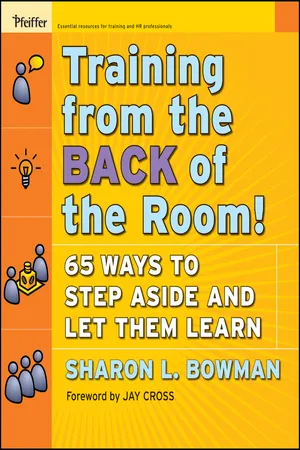
eBook - ePub
Training From the Back of the Room!
65 Ways to Step Aside and Let Them Learn
Sharon L. Bowman
This is a test
Share book
- English
- ePUB (mobile friendly)
- Available on iOS & Android
eBook - ePub
Training From the Back of the Room!
65 Ways to Step Aside and Let Them Learn
Sharon L. Bowman
Book details
Book preview
Table of contents
Citations
About This Book
From Sharon L. Bowman, the author of the best-selling Ten-Minute Trainer, comes the dynamic new book, Training from the BACK of the Room! This innovative resource introduces 65 training strategies that are guaranteed to deliver outstanding training results no matter what the topic, group, or learning environment. Now, trainers can replace the traditional "Trainers talk; learners listen" paradigm with a radical new model for designing and delivering instruction: "When learners talk and teach, they learn."
Frequently asked questions
How do I cancel my subscription?
Can/how do I download books?
At the moment all of our mobile-responsive ePub books are available to download via the app. Most of our PDFs are also available to download and we're working on making the final remaining ones downloadable now. Learn more here.
What is the difference between the pricing plans?
Both plans give you full access to the library and all of Perlego’s features. The only differences are the price and subscription period: With the annual plan you’ll save around 30% compared to 12 months on the monthly plan.
What is Perlego?
We are an online textbook subscription service, where you can get access to an entire online library for less than the price of a single book per month. With over 1 million books across 1000+ topics, we’ve got you covered! Learn more here.
Do you support text-to-speech?
Look out for the read-aloud symbol on your next book to see if you can listen to it. The read-aloud tool reads text aloud for you, highlighting the text as it is being read. You can pause it, speed it up and slow it down. Learn more here.
Is Training From the Back of the Room! an online PDF/ePUB?
Yes, you can access Training From the Back of the Room! by Sharon L. Bowman in PDF and/or ePUB format, as well as other popular books in Business & Human Resource Management. We have over one million books available in our catalogue for you to explore.
part ONE
Connections

What You Need to Know About Connections
Since most learning is social, wouldn’t it be more effective to put [learners] in touch with others so they can learn from one another?
Jay Cross
Informal Learning, 2007, p. 39
Informal Learning, 2007, p. 39
Basic Concept Map for This Chapter
As you read, write a summary for each concept.


CONNECTIONS

One-Minute Connection: Fast Pass
Check off one or more of the sentences below that describe the usual ways most traditional training programs begin:
• Trainer welcomes learners and introduces himself/herself.
• Trainer announces the training title, topics, and learning objectives.
• If using slides, trainer reads aloud the training title, purpose, goals, and learning objectives displayed on the screen.
• Trainer reviews ground rules and housekeeping suggestions (breaks, exits, bathroom locations, cell phone protocol, and the like).
• Learners stand and introduce themselves.
• Learners participate in an icebreaker or social activity that may have nothing to do with the training topic.
You probably checked off most, if not all, of the sentences because they all describe components of the beginning of traditional training programs.There is nothing wrong with this list, except that these components have nothing to do with learning.
That is not to say that these pieces should be left out of the opening.They can be included later; they just don’t belong at the very beginning of a training. Something else needs to happen first so that participants are learning from the moment they walk in the door. In this chapter, you will discover the importance of connections, and why and how to engage learners right from the start.
Imagine That . . .
You are attending a training about a new database program your company has purchased. This is highly technical information that is being taught in a computer lab. You are somewhat familiar with the program’s general features because you read the electronic overview that the company sent to you as part of the training warm-up exercises. You walk in expecting to sit at a computer and wait for the trainer, Marie, to begin talking. Instead, you notice a slide displayed on the front screen that says: “Please form a standing group with three other employees and tell them what you learned from the overview page you read before coming here.” Upbeat music plays in the background as you join a standing group and begin discussing what you already know about the database program.
After a few minutes, Marie directs everyone’s attention to a wall chart on which she has listed learning outcomes for the training. She passes out sheets of colored dots and explains that you will read the chart and place dots beside two learning outcomes that, for you, are the most important. After sticking the two dots to the chart, you find a computer station and sit down. You notice that you are sitting next to another employee and that you will be working as partners on the same computer as you learn the new program.
Marie gives you another couple of minutes to tell your computer partner which learning outcomes you dotted, why you dotted them, and what you want to take away from the training.
Only now does Marie introduce herself. She summarizes what you have done so far, what you will learn, and other general suggestions for making the training a success.
What have you done during the first ten minutes of this training? Let’s make a short list:
• You made some mental connections with what you already know and what you really want to learn.
• You made social connections with the other learners in content-related ways, first by forming standing groups, and then by pairing up with a computer partner. Both times you discussed information related to the training topic.
• You reviewed the learning outcomes three times and three different ways: by reading them silently, evaluating and prioritizing them with the dots, and explaining them to a partner.
You didn’t realize it, but you actually participated in three connection activities: a Standing Fast Pass, Dot-Voting, and a Turn and Talk. Marie waited until after the connection activities were over before she gave her introduction and class overview.

CONCEPTS
Connections are short, learner-focused opening activities that include the following four important elements:
• Connecting learners to other learners in positive and meaningful ways that are relevant to the training topic
• Connecting learners to the topic, that is, to what they already know, or think they know, about the information to be learned
• Connecting learners to their own learning goals—what they personally want to take away from the training
• Connecting learners to the learning outcomes—what they will be able to do as a result of what they learn
In addition, learners also connect to the trainer and to the training environment. This means that learners begin to feel relaxed and at ease with the trainer—they see the trainer as friendly, knowledgeable, professional yet approachable. And they feel comfortable in the learning environment, which is welcoming, informal, visually pleasant, and mentally stimulating.
With opening activities that engage learners from the moment they walk into the room, learners can make all these connections in a matter of a few minutes. With connections, learners quickly become interested, engaged, intrigued, motivated, and eager to learn more.
Let’s take a closer look at these four connection elements.
Connecting Learners to Learners
Most people learn better when they are with friends rather than with a group of strangers. This is because humans usually feel psychologically safer with people they know. Psychological safety means that learners can
• Ask questions.
• Try things out.
• Make mistakes.
• Express opinions.
• Take risks while learning.
Psychological safety, therefore, is really important to the learning process.
Often, people who attend a training together also work together. Trainers may assume that, because they work together, they are friends, or at least on friendly terms with each other. Because of this assumption, trainers may think that individuals in the group feel safe with one another. This is not always the case.
Some work environments are tense, stressful places, competitive rather than cooperative, where employees learn to hide mistakes, refrain from voicing opinions or asking questions, and play it safe rather than taking risks. So when people who work together attend a training together, they may not automatically feel safe with each other. Psychological safety must be designed and built into the learning experience, and it must be nurtured during the entire time learners spend together.
During a training program, psychological safety goes deeper than learners simply introducing themselves to each other or sharing a few facts about themselves with other learners. In training, psychological safety means that, from the moment learners enter the room, they are immersed in meaningful, topic-related activities that help them form a strong learning community, that is, a group of folks who share a common goal of learning together in positive, respectful ways. As Jay Cross puts it in Informal Learning (2007), “Learning is social. We learn from, by, and with other people. . . . Learning is best understood as an interaction among practitioners, rather than a process in which a producer provides knowledge to a consumer” (p. 63).
Connecting Learners to Topic
No matter what the age, culture, or gender, learners do not come to a learning experience with blank slates for brains. Learners, especially adults, come with experiences and information they have gathered along the way, some of it accurate and s...